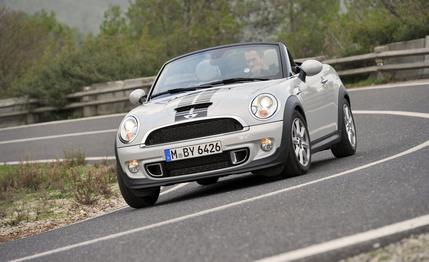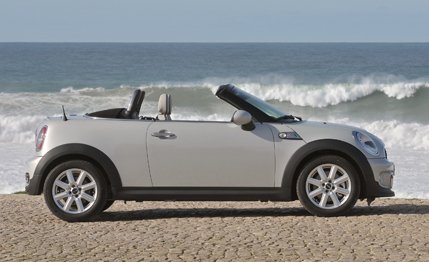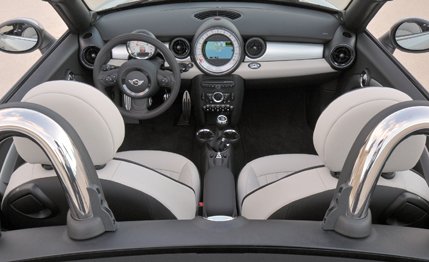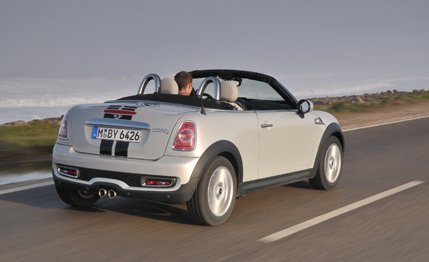 First Drive Review
First Drive Review
Remember the old joke about how to lose 10 ugly pounds? Right, cut off your head. Here’s an automotive sequel. Although this car didn’t lose weight when its football-helmet coupe top was lopped off—it’s actually about 90 pounds heavier than its hard-shelled sibling—it definitely lost a lot of ugly.
Is ugly a little strong for the Mini coupe? Perhaps, but the topless version makes an invidious contrast, and its softtop looks more natural than the coupe’s fixed roof. And with the top down and the pop-up rear wing deployed (at 50 mph), the roadster becomes a chunky little bulldog of a sports car with a level of c’mon-let’s-play appeal that’s hard to resist.
With a price range of $25,050 to $35,200, exclusive of the myriad options, the roadsters—in Cooper, Cooper S, and John Cooper Works strengths—are second only to the convertibles in price among members of the steadily expanding Mini family. But they’re at the low end of the droptop sporty-car milieu. Only Mazda’s evergreen Miata is less expensive, and the next tier of roadsters—the Audi TT, the BMW Z4, the Porsche Boxster—begins revving up at well over $40,000.

Shared Beginnings
The coupe and the roadster were developed simultaneously, with launch dates staggered by four months. The former went on sale late last fall; the latter hits dealerships on February 25. This is the sixth Mini variant to appear since BMW revived the brand in 2001 and the first roadster ever to wear Mini badges. As with any convertible conversion, removing the roof structure required compensatory body-shell stiffening. The coupe and the roadster both use the Mini convertible as their starting point. A torsion bar spans the roadster rail to rail behind and below the seats, and there’s other bracing below the car. There’s more structure at the rocker-panel level, the windshield surround has been strengthened, and the foundation of the twin stainless-steel rollover bars—fixed rather than the pop-ups used in the two-plus-two convertible—adds a little extra rigidity.
An unlined cloth top, with exposed bows, spans the cockpit. The forward portion is stretched over a sheet-steel foundation that attaches to the windshield header with a single latch, and it doubles as a tonneau when the top is stowed behind the seats—with no loss of trunk space. The standard top operates manually; a power version will be available as a $750 option.
Shared Power
Powertrains are Mini familiar: three versions of the corporate 1.6-liter four—121 hp (naturally aspirated), 181 hp (the turbocharged S version), 208 hp (the higher-output JCW turbo)—with a six-speed manual gearbox (standard) or six-speed Steptronic automatic ($1250, limited to base and S models). The options list is comprehensive almost beyond comprehension, and incautious ordering could easily result in a Mini roadster with an Audi TT price. Standard equipment for the base roadster includes air conditioning, power mirrors, an AM/FM/CD audio system with an auxiliary jack, an onboard computer, and a leather-wrapped multifunction steering wheel.

Our preview test car, an S version with the manual transmission, had a number of extra-cost indulgences, such as Lounge leather upholstery ($2000), a $1750 Premium package (alarm, keyless entry, auto-dimming rearview mirror, rain sensor, auto headlights, auto climate control, chrome interior trim), and the Technology package (it includes the Mini Connected telematics system, a 10-speaker Harman/Kardon audio system, and parking sensors). Opting for the Tech package makes navigation a $750 option; without the Tech package, you can get nav and Mini Connected for $1750. There was no window sticker, but we were looking at a Cooper S roadster that cost about $32,000. At least.
A Shared Experience
On mountain roads, the roadster feels like other members of its burgeoning tribe: quick on its feet, responsive, and solid—thanks to the aforementioned strengthening measures—despite occasional trembling in the dashboard and subdural structure. The steering is quick, informative, and accurate; braking is powerful and easy to modulate; shift engagements are precise; and throttle response is instantaneous. Mini predicts 0 to 62 mph in 7.0 seconds, and having hit 60 mph in 6.6 with an S coupe we have no reason to doubt it. The EPA economy forecast is 27 mpg city and 35 mpg highway.
Like other Minis, the roadster offers a lot of behind-the-wheel pleasure, enhanced here by sun-in-face, etc. Wind-in-hair can be mitigated, although not eliminated, by a detachable wind blocker that straddles the roll hoops. The seats are long-haul comfortable and high-g-load supportive, and the nav system is easy to use and readable even with sun on the screen.

There are a few demerits. In higher-performance Minis, the combination of run-flat tires, stiff springs, and granitic suspension bushings produces ride quality that can be punishing. No bump is too small to ignore. Wind noise becomes excessive above 60 mph, thanks to the single-layer top, and rear sightlines are poor with the top up.
Still, the pros outweigh the cons here. If the roadster has room for only two versus the two-plus-two convertible, your lone passenger will feel flattered, and you’ll have a little more room for weekend cargo—2.5 more cubic feet than in the two-plus-two—as well as a pass-through that allows stowage on the fly. Beyond that, you’ll have the most stylish Mini yet created. If Sir Alec Issigonis—creator of the original Mini—were still around, he’d be kicking himself for not doing it first.